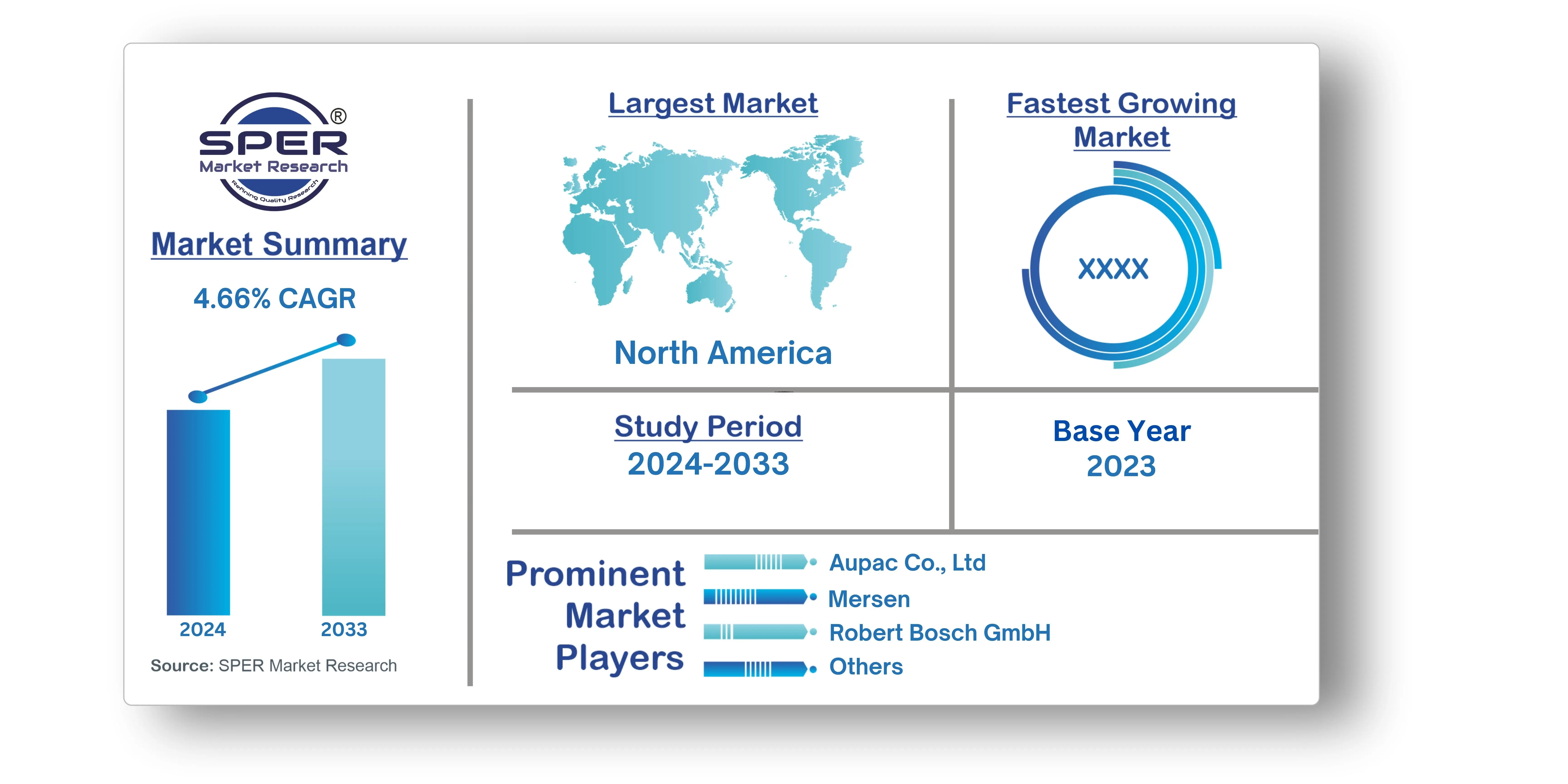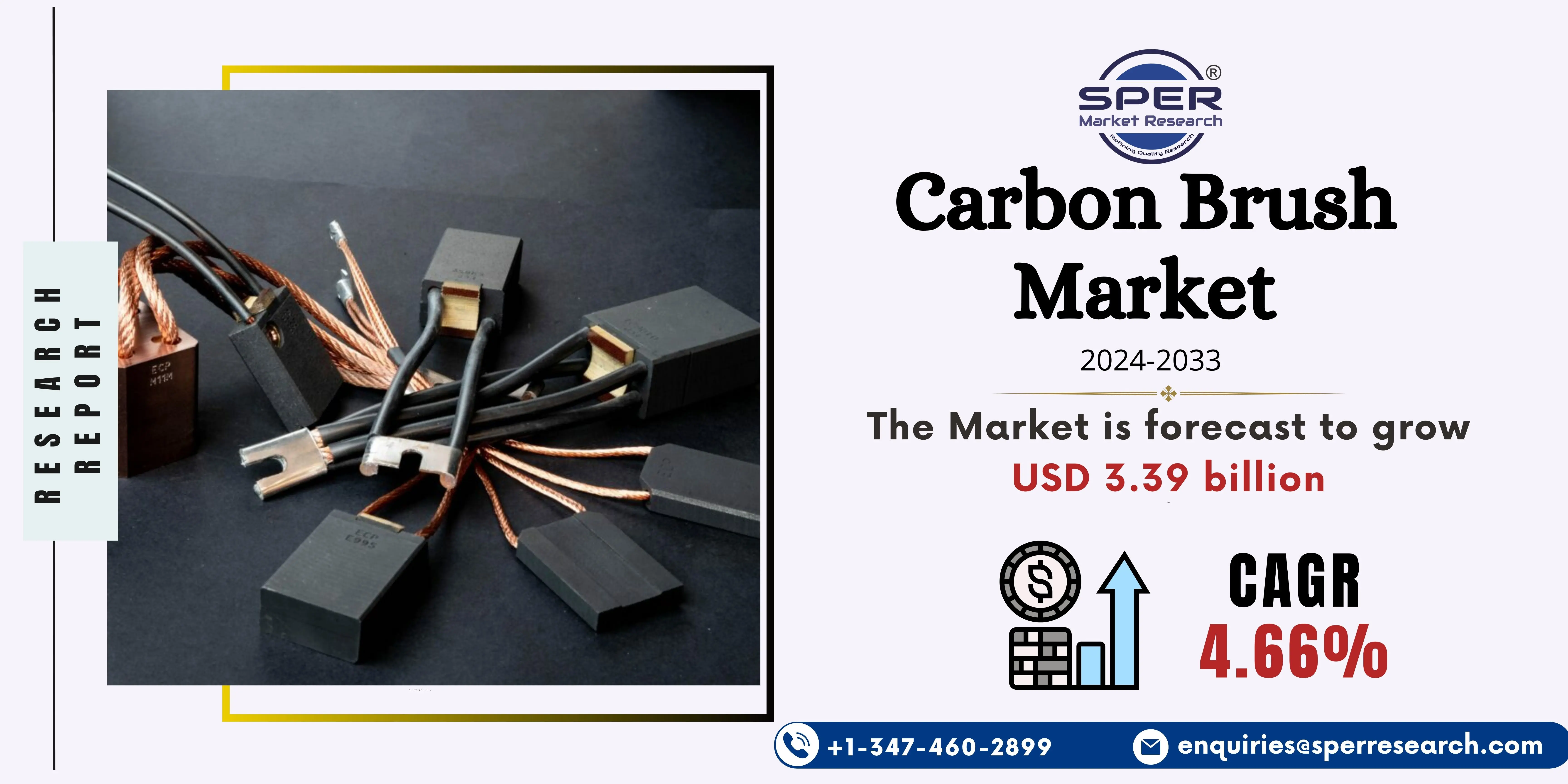
Carbon Brush Market Growth, Size, Trends, Demand, Revenue, Competition and Future Outlook
Carbon Brush Market Size- By Type, By Application, By Industry- Regional Outlook, Competitive Strategies and Segment Forecast to 2033
| Published: Apr-2024 | Report ID: SEMI2412 | Pages: 1 - 222 | Formats*: |
| Category : Semiconductor and Electronics | |||
- January 2023: Bosch Power Tools unveiled the GWS 800 Professional angle grinder in January 2023. The product's remarkable Carbon Brush was made to simplify maintenance, and it was produced in Chennai, India.
- April 2021: To help businesses automate their grinding, polishing, and brushing operations, 3M, a maker of industrial abrasives, and Schunk, a German provider of gripping systems and clamping technologies, teamed together in April 2021.


| Report Metric | Details |
| Market size available for years | 2020-2033 |
| Base year considered | 2023 |
| Forecast period | 2024-2033 |
| Segments covered | By Type, By Application, By Industry |
| Regions covered | North America, Asia-Pacific, Latin America, Middle East & Africa and Europe |
| Companies Covered | Aupac Co. Ltd, Avo Carbon Products Inc, Elektrokarbon, Helwig Carbon Products Inc, Morgan Advanced Materials, Mersen, Robert Bosch GmbH, Schmidthammer Electrokohle, Schunk GmBH, Toyo Tanso Co.Ltd. |
- Manufacturers and Suppliers
- End Use Industry
- Maintenance and Repair Service Providers
- Distributors and Resellers
- Original Equipment Manufacturer
- Research and Development Institutes
- Consulting Firms and Industry Association
- Investors and Financial Institution
| By Type: |
|
| By Application: |
|
| By Industry: |
|
- Global Carbon Brush Market Size (FY’2024-FY’2033)
- Overview of Global Carbon Brush Market
- Segmentation of Global Carbon Brush Market By Type(Graphite, Carbon Graphite ,Electro Graphite, Metal Graphite, Others)
- Segmentation of Global Carbon Brush Market By Application(Grounding Devices, Generators and Alternators, Motors, Signal and Power Transmission, Others)
- Segmentation of Global Carbon Brush Market By Industry (Automotive, Household, Electrical, Industrial, Others)
- Statistical Snap of Global Carbon Brush Market
- Expansion Analysis of Global Carbon Brush Market
- Problems and Obstacles in Global Carbon Brush Market
- Competitive Landscape in the Global Carbon Brush Market
- Impact of COVID-19 and Demonetization on Global Carbon Brush Market
- Details on Current Investment in Global Carbon Brush Market
- Competitive Analysis of Global Carbon Brush Market
- Prominent Players in the Global Carbon Brush Market
- SWOT Analysis of Global Carbon Brush Market
- Global Carbon Brush Market Future Outlook and Projections (FY’2024-FY’2033)
- Recommendations from Analyst
1.1. Scope of the report1.2. Market segment analysis
2.1. Research data source2.1.1. Secondary Data2.1.2. Primary Data2.1.3. SPER’s internal database2.1.4. Premium insight from KOL’s2.2. Market size estimation2.2.1. Top-down and Bottom-up approach2.3. Data triangulation
4.1. Driver, Restraint, Opportunity and Challenges analysis
4.1.1. Drivers4.1.2. Restraints4.1.3. Opportunities4.1.4. Challenges
4.2. COVID-19 Impacts of the Global Carbon Brush Market
5.1. SWOT Analysis5.1.1. Strengths5.1.2. Weaknesses5.1.3. Opportunities5.1.4. Threats5.2. PESTEL Analysis5.2.1. Political Landscape5.2.2. Economic Landscape5.2.3. Social Landscape5.2.4. Technological Landscape5.2.5. Environmental Landscape5.2.6. Legal Landscape5.3. PORTER’s Five Forces5.3.1. Bargaining power of suppliers5.3.2. Bargaining power of buyers5.3.3. Threat of Substitute5.3.4. Threat of new entrant5.3.5. Competitive rivalry5.4. Heat Map Analysis
6.1. Global Carbon Brush Market Manufacturing Base Distribution, Sales Area, Product Type6.2. Mergers & Acquisitions, Partnerships, Product Launch, and Collaboration in Global Carbon Brush Market
7.1. Global Carbon Brush Market Value Share and Forecast, By Type, 2024-20337.2. Graphite7.3. Carbon Graphite7.4. Electro Graphite7.5. Metal Graphite7.6. Others
8.1. Global Carbon Brush Market Value Share and Forecast, By Application, 2024-20338.2. Grounding Devices8.3. Generators and Alternators8.4. Motors8.5. Signal and Power Transmission8.6. Others
9.1. Global Carbon Brush Market Value Share and Forecast, By Industry, 2024-2033
9.2. Automotive9.3. Electrical9.4. Household9.5. Industrial9.6. Others
10.1. Global Carbon Brush Market Size and Market Share
11.1. Global Carbon Brush Market Size and Market Share By Type(2020-2026)11.2. Global Carbon Brush Market Size and Market Share By Type (2027-2033)
12.1. Global Carbon Brush Market Size and Market Share By Application (2020-2026)12.2. Global Carbon Brush Market Size and Market Share By Application (2027-2033)
13.1. Global Carbon Brush Market Size and Market Share By Industry (2020-2026)13.2. Global Carbon Brush Market Size and Market Share By Industry(2027-2033)
14.1. Global Carbon Brush Market Size and Market Share By Region (2020-2026)14.2. Global Carbon Brush Market Size and Market Share By Region (2027-2033)14.3. Asia-Pacific14.3.1. Australia14.3.2. China14.3.3. India14.3.4. Japan14.3.5. South Korea14.3.6. Rest of Asia-Pacific14.4. Europe14.4.1. France14.4.2. Germany14.4.3. Italy14.4.4. Spain14.4.5. United Kingdom14.4.6. Rest of Europe14.5. Middle East and Africa14.5.1. Kingdom of Saudi Arabia14.5.2. United Arab Emirates14.5.3. Rest of Middle East & Africa14.6. North America14.6.1. Canada14.6.2. Mexico14.6.3. United States14.7. Latin America14.7.1. Argentina14.7.2. Brazil14.7.3. Rest of Latin America
15.1. Aupac Co., Ltd15.1.1. Company details15.1.2. Financial outlook15.1.3. Product summary15.1.4. Recent developments15.2. Avo Carbon Products Inc15.2.1. Company details15.2.2. Financial outlook15.2.3. Product summary15.2.4. Recent developments15.3. Elektrokarbon15.3.1. Company details15.3.2. Financial outlook15.3.3. Product summary15.3.4. Recent developments15.4. Helwig Carbon Products Inc15.4.1. Company details15.4.2. Financial outlook15.4.3. Product summary15.4.4. Recent developments15.5. Morgan Advanced Materials15.5.1. Company details15.5.2. Financial outlook15.5.3. Product summary15.5.4. Recent developments15.6. Mersen15.6.1. Company details15.6.2. Financial outlook15.6.3. Product summary15.6.4. Recent developments15.7. Robert Bosch GmbH15.7.1. Company details15.7.2. Financial outlook15.7.3. Product summary15.7.4. Recent developments15.8. Schmidthammer Electrokohle15.8.1. Company details15.8.2. Financial outlook15.8.3. Product summary15.8.4. Recent developments15.9. Schunk GmBH15.9.1. Company details15.9.2. Financial outlook15.9.3. Product summary15.9.4. Recent developments15.10. Toyo Tanso Co.Ltd.15.10.1. Company details15.10.2. Financial outlook15.10.3. Product summary15.10.4. Recent developments15.11. Others
SPER Market Research’s methodology uses great emphasis on primary research to ensure that the market intelligence insights are up to date, reliable and accurate. Primary interviews are done with players involved in each phase of a supply chain to analyze the market forecasting. The secondary research method is used to help you fully understand how the future markets and the spending patterns look likes.
The report is based on in-depth qualitative and quantitative analysis of the Product Market. The quantitative analysis involves the application of various projection and sampling techniques. The qualitative analysis involves primary interviews, surveys, and vendor briefings. The data gathered as a result of these processes are validated through experts opinion. Our research methodology entails an ideal mixture of primary and secondary initiatives.



Frequently Asked Questions About This Report
PLACE AN ORDER
Year End Discount
Sample Report
Pre-Purchase Inquiry
NEED CUSTOMIZATION?
Request CustomizationCALL OR EMAIL US
100% Secure Payment






Related Reports
Our Global Clients
Our data-driven insights have influenced the strategy of 200+ reputed companies across the globe.




















